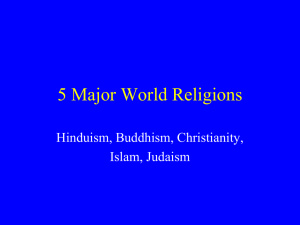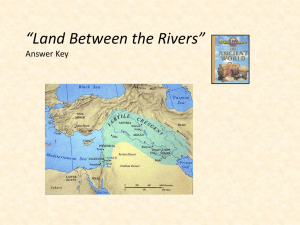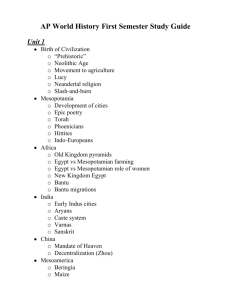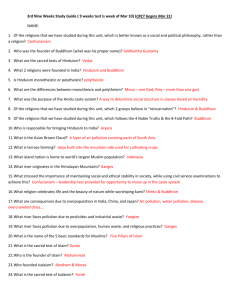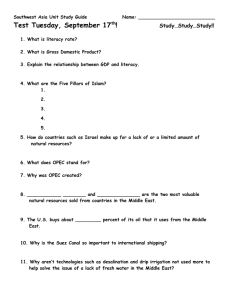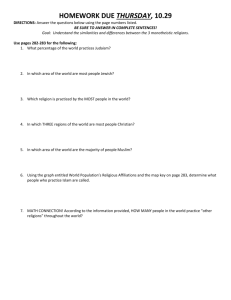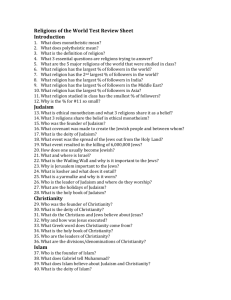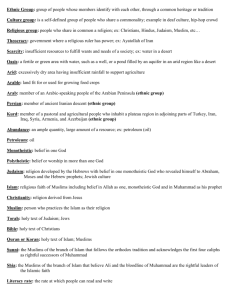NAME PERIOD _____ DATE: October 29, 2009
advertisement
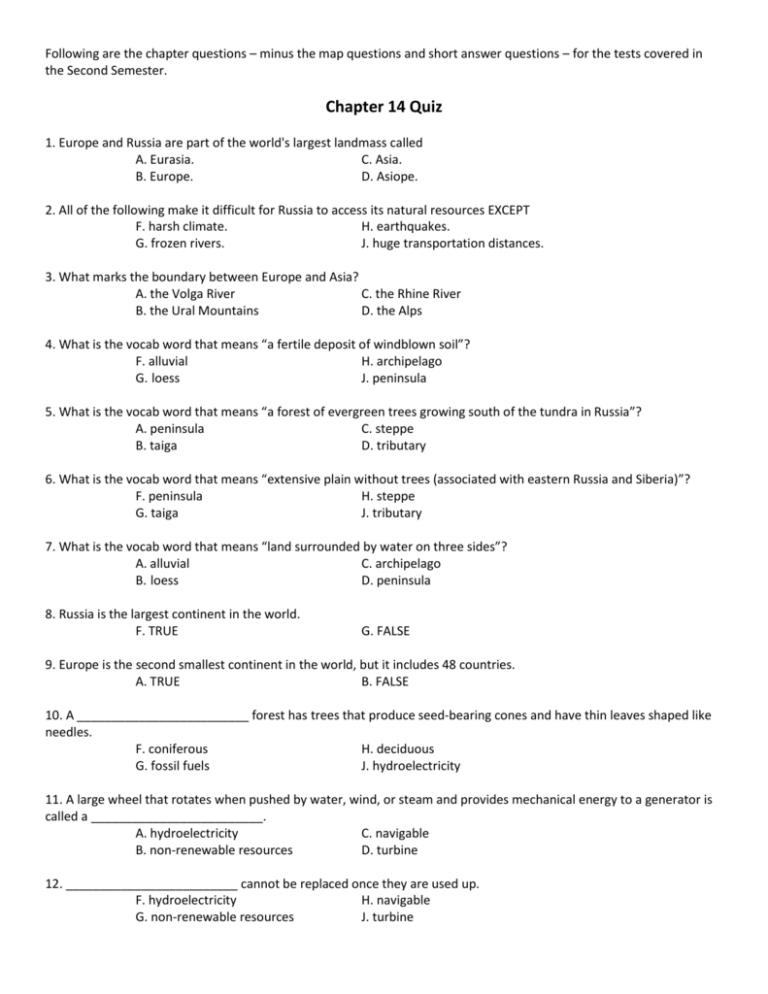
Following are the chapter questions – minus the map questions and short answer questions – for the tests covered in the Second Semester. Chapter 14 Quiz 1. Europe and Russia are part of the world's largest landmass called A. Eurasia. C. Asia. B. Europe. D. Asiope. 2. All of the following make it difficult for Russia to access its natural resources EXCEPT F. harsh climate. H. earthquakes. G. frozen rivers. J. huge transportation distances. 3. What marks the boundary between Europe and Asia? A. the Volga River C. the Rhine River B. the Ural Mountains D. the Alps 4. What is the vocab word that means “a fertile deposit of windblown soil”? F. alluvial H. archipelago G. loess J. peninsula 5. What is the vocab word that means “a forest of evergreen trees growing south of the tundra in Russia”? A. peninsula C. steppe B. taiga D. tributary 6. What is the vocab word that means “extensive plain without trees (associated with eastern Russia and Siberia)”? F. peninsula H. steppe G. taiga J. tributary 7. What is the vocab word that means “land surrounded by water on three sides”? A. alluvial C. archipelago B. loess D. peninsula 8. Russia is the largest continent in the world. F. TRUE G. FALSE 9. Europe is the second smallest continent in the world, but it includes 48 countries. A. TRUE B. FALSE 10. A _________________________ forest has trees that produce seed-bearing cones and have thin leaves shaped like needles. F. coniferous H. deciduous G. fossil fuels J. hydroelectricity 11. A large wheel that rotates when pushed by water, wind, or steam and provides mechanical energy to a generator is called a _________________________. A. hydroelectricity C. navigable B. non-renewable resources D. turbine 12. _________________________ cannot be replaced once they are used up. F. hydroelectricity H. navigable G. non-renewable resources J. turbine 13. Many of the rivers in Europe are _________________________, because they are wide or deep enough for ships to be able to pass through A. hydroelectricity C. navigable B. non-renewable resources D. turbine 14. How does Siberia's climate affect life in that region? F. Many people live there. H. It is a major transportation center. G. Few people live there. J. Many major cities are located there. 15. The countries around the Mediterranean Sea are dry because they are in the rain shadow of the A. Ural Mountains. C. Alpine Mountain System. B. Northwestern Highlands. D. Central Uplands. 16. A deciduous forest is made up of F. evergreen trees. G. trees that lose their leaves. H. cacti. J. palm trees. 17. What is the name of the part of Russia that is east of the Ural Mountains? A. Silesia C. the North European Plain B. Siberia D. the Central Uplands Chapter 15 Quiz 18. What term is used to describe nations taking over other countries and turning them into colonies? F. nationalism H. communism G. imperialism J. socialism 19. What Congress, whose members were elected by the people, did Czar Nicholas II agree to establish? A. the Duma C. the Senate B. the Kiev D. Parliament 20. The rule of Augustus, the first emperor of Rome, was the beginning of 200 years of peace known as the F. Pax Romana. H. Golden Age. G. Cold War. J. Renaissance. 21. The period in the late 1700s when scientists started to base their theories on watching the world rather than on religious beliefs is called A. the Scientific Revolution. C. the Industrial Revolution. B. calculus. D. the hypothesis. 22. What is the vocab word that means “a form of unlimited government in which the state owns the factories and the farms”? F. alliance H. Cold War G. Communism J. czar 23. What is the vocab word that means “collection of lands ruled by a single government”? A. czar C. dictator B. empire D. feudalism 24. What is the vocab word that means “power struggle and tension between the Soviet Union and the United States after World War II that never included warfare”? F. alliance H. Cold War G. Communism J. czar 25. What is the vocab word that means “a political system in which there is no central government, and a social system where by a powerful lord would offer protection in return for service"? A. czar C. dictator B. empire D. feudalism 26. Humanism is a philosophy from the Renaissance in which a person should improve this world rather than hoping for a better life after death. F. TRUE G. FALSE 27. The change in the way things were made (using more metals and plastics) was called the Industrial Revolution. A. TRUE B. FALSE 28. Nationalism is when you believe everything your government tells you. F. TRUE G. FALSE 29. The western Mediterranean region, near Spain where Jesus lived, was called Palestine. A. TRUE B. FALSE 30. _________________________, like Congress, is an elected body of legislators. F. Parliament H. policy G. Renaissance J. revolution 31. The President has a _________________________ for insuring everyone has good health care. A. Parliament C. policy B. Renaissance D. revolution 32. The _________________________ was the rebirth of education and the arts. F. Parliament H. policy G. Renaissance J. revolution 33. A _________________________, or peasant, worked the land for a King, Lord, or Knight in exchange for protection and a small garden to feed his family. A. revolution C. serf B. textile D. westernization 34. Many of the _________________________ factories in the U.S. have closed, as it is less expensive to make socks and towels in other countries. F. revolution H. serf G. textile J. westernization 35. Which two countries fought the Cold War? A. Germany and Japan B. the U.S. and the Soviet Union C. Cuba and the Soviet Union D. Great Britain and Germany 36. The ancient Greeks developed which of the following types of government? F. monarchy H. communism G. dictatorship J. democracy 37. The Mongol conquerors who dominated Russia for almost 250 years were called the A. "Barbarians." C. "Golden Horde." B. "Vikings." D. "Muscovy Archers." Chapter 16 Quiz 1. The spreading of ideas that support some cause is called A. migration. C. heritage. B. repression. D. propaganda. 2. Over 80% of the Russian people belong to what ethnic group? F. Turks H. Magyars G. Yakuts J. Russian Slavs 3. The nonviolent change in power in Czechoslovakia was called the A. Velvet Revolution. C. Cold War. B. Great Peace. D. Slovak Revolution. 4. The term for customs and practices that are passed between generations is F. culture. H. heritage. G. language. J. ethnicity. 5. Why are nearly all Russians able to read and write? A. Russians must pass reading and writing tests to get jobs. B. Almost all Russians are schooled at home. C. Everyone attends religious schools. D. School was free under the old communist system and continues to be free for all people. 6. What vocabulary word means “the movement of persons from one country or locality to another”? F. migration H. multicultural G. repress J. tariff 7. What vocabulary word means “a government tax on imports”? A. multicultural C. repress B. tariff D. urbanization 8. What vocabulary word means “to hold back, to put down, or check by force”? F. migration H. multicultural G. repress J. tariff 9. What vocabulary word means “movement of people from rural areas to cities”? A. multicultural C. repress B. tariff D. urbanization 10. What vocabulary word means “having to do with many cultures”? F. migration H. multicultural G. repress J. tariff 11. The prosperity of Western Europe is based on industry. Factories make consumer goods that are in great demand around the world. A. TRUE B. FALSE 12. Many workers in Western Europe are given six (6) weeks of vacation every year. F. TRUE G. FALSE 13. The Slavs are one of the smallest ethnic groups in Eastern Europe. A. TRUE B. FALSE 14. Peter the Great founded (created) the city of St. Petersburg in 1703. F. TRUE G. FALSE 15. There are more than 75 different ethnic groups living in Russia today. A. TRUE B. FALSE 16. _________________________ is a policy in which a strong nation seeks to dominate other countries politically, socially, and economically. F. ethnic group H. imperialism G. monarch J. N.A.T.O. 17. _________________________ was a Russian author remembered for two great novels, Anna Karenina and War and Peace. A. N.A.T.O. C. Peter Tchaikovsky B. Leo Tolstoy D. westernization 18. _________________________ is an alliance, made in 1949 to defend one another if they were attacked by a communist country, that included the US, England, France, Canada, and Western European countries. F. ethnic group H. imperialism G. monarch J. N.A.T.O. 19. _________________________ was the Russian composer who wrote the ballet music for Sleeping Beauty, Swan Lake, and The Nutcracker. A. N.A.T.O. C. Peter Tchaikovsky B. Leo Tolstoy D. westernization 20. _________________________ is the adoption of western ideas, technology, and culture. F. ethnic group H. imperialism G. monarch J. westernization 21. Almost all of the people in Hungary belong to what ethnic group? A. Slavs C. Bulgars B. Albanians D. Magyars 22. Why was Poland easy to conquer? F. There are few natural barriers to keep invaders out. G. Poland's people refused to fight. H. Poland had no army. J. Poland's people were poor and starving. 23. In 1993, Czechoslovakia became two countries, Slovakia and A. the Democratic Republic of Czechs. C. the Czech Republic. B. Bohemia. D. Moravia. 24. Which of the following statements best describes the workforce in most Western European countries? F. Most people work in agriculture. G. Most people work in factories. H. Most people work in factories or in service industries. J. Workers are evenly divided between agriculture, industry, and services. 25. In 1795, Russia, Prussia, and Austria divided Poland among themselves and Poland did not become an independent country again until A. ten years later. C. 100 years later. B. after World War I. D. after World War II. Chapter 19 Quiz 1. What do most of Africa's people do for a living? A. farming B. manufacturing C. fishing D. mining 2. Most of Africa's major lakes are located near a deep trench named the F. Grand Canyon. H. Valley of the Dead. G. Great Rift Valley. J. Rift of Tanzania. 3. Many African countries are trying to diversify their economies by A. growing more cash crops. C. creating manufacturing jobs. B. encouraging people to farm. D. inviting foreign companies to open mines. 4. The country of Ghana was once called the Gold Coast because F. it was a major gold exporter. H. the great sandy beaches were gold in color. G. rich people vacationed there. J. ancient gold statues lined the cities. 5. The sources of the Nile are the A. White Nile and Red Nile. B. Blue Nile and White Nile. C. Red Nile and Blue Nile. D. Red Nile and Green Nile. 6. What is silt? F. widespread cutting of forests G. farming in which only enough food to feed one's family is produced H. a mixture of tiny bits of soil and rock carried and deposited by a river J. a smaller stream flowing into a larger stream or river 7. What is a rift? A. a flat grassland in tropical or subtropical regions B. a spot of fertile land in a desert, fed by water from wells or underground springs C. rock filled rapids D. deep trench 8. What does deforestation mean? F. widespread cutting of forests G. farming in which only enough food to feed one's family is produced H. a mixture of tiny bits of soil and rock carried and deposited by a river J. a smaller stream flowing into a larger stream or river 9. What is a savanna? A. a flat grassland in tropical or subtropical regions B. a spot of fertile land in a desert, fed by water from wells or underground springs C. rock filled rapids D. deep trench 10. What is an oasis? F. a flat grassland in tropical or subtropical regions G. a spot of fertile land in a desert, fed by water from wells or underground springs H. rock filled rapids J. deep trench 11. The Sahara Desert is about twice the same size of Canada. A. True B. False 12. West Africa is the most populated region of Africa. F. True G. False 13. Fishing and subsistence farming are two important parts of Africa’s economy. A. True B. False 14. Africa is called the “plateau continent.” F. True G. False 15. Africa has few factories to make products from its own raw materials. A. True B. False 16. _________________________ are people who move from place to place to earn a living. F. nomads H. subsistence farming G. transportation barrier J. tributary 17. Rivers are used for traveling, but _________________________, or rock-filled rapids, can make the journey difficult. A. cataracts C. escarpment B. fertile D. irrigate 18. Silt helps make the soil _________________________, as it contains substances plants need in order to grow well. F. cataracts H. escarpment G. fertile J. irrigate 19. _________________________ are physical features that make it difficult to transport goods from one place to another. A. nomads C. subsistence farming B. transportation barrier D. tributary 20. The coastal plains of Ghana ends at a long _________________________, or steep cliff, that is about as high as a 100-story skyscraper. F. cataracts H. escarpment G. fertile J. irrigate 21. The Aswan High Dam was built to A. control flooding. B. reduce the amount of silt on the land. C. encourage cash crops. D. increase the amount of silt on the land. 22. Why is it impossible for ships to sail from Africa's interior to the sea? F. Cataracts interrupt the flow of the rivers. G. Escarpments interrupt the flow of the rivers. H. Rift valleys interrupt the flow of the rivers. J. Tributaries interrupt the flow of the rivers. 23. Where are most of the oil reserves in Africa? A. in South and East Africa B. in North and West Africa C. in East and North Africa D. in West and South Africa 24. Most people in the Sahara make their living from F. cash crop farming. G. manufacturing and trade. H. commercial fishing. J. nomadic herding. 25. What is most of Africa's land used for? A. timber B. mining C. subsistence farming D. cash crop farming Chapter 20 Test 1. What famous king of Mali based his laws on the Quran? A. Kwame Nkrumah B. Tutankhamen C. Leopold Sedar Senghor D. Mansa Musa 2. What city in Songhai became a great Muslim learning center? F. Kilwa H. Tombouctou G. Malindi J. Mombasa 3. What was important about the movement of the Bantu-speakers? A. They won the right to vote. B. They spread their religion throughout Africa. C. They introduced farming, herding, and iron tools to several regions. D. They introduced Christianity to West Africa. 4. What effect did trade with Muslims have on the city-states of East Africa? F. A new language called Swahili developed. G. The city-states declined. H. The Muslims altered the flow of the East African trading routes. J. The city-states became powerful empires. 5. What event inspired Africans to win their freedom and weakened colonial power in Africa? A. the conclusion of the slave trade C. the Pan-African movement B. World War II D. the Russian Revolution 6. A quantity much larger than is needed is called a F. ethnic group. G. fertile. H. pilgrimage. J. surplus. 7. A community with political and economic control over the surrounding countryside is called a A. city-state. C. colonize. B. civilization. D. domesticate. 8. A religious journey is called a F. ethnic group. G. fertile. H. pilgrimage. J. surplus. 9. A ____________ requires cities, governments, job specialization, art, architecture, and writing. A. city-state C. colonize B. civilization D. domesticate 10. Land that is productive and grows a lot of crops is often called F. ethnic group. H. pilgrimage. G. fertile. J. surplus. 11. Around 1000 B.C. Aksum was a bustling trade center along the Red Sea, near modern-day Ethiopia and Eritrea. A. TRUE B. FALSE 12. Bantu-speakers settled in Central and Southern Africa. F. TRUE G. FALSE 13. While some African nations won their independence peacefully, Algeria had to fight for its independence from France. A. TRUE B. FALSE 14. Even before the arrival of the Europeans, slavery was common in Africa. F. TRUE G. FALSE 15. For 20 million Africans, their last view of their homeland was through an opening called “The Door of No Return.” A. TRUE B. FALSE 16. A poet and leader of Pan-Africanism, _________________________ encouraged Africans to study their traditions and be proud of their culture. Later he became the first president of Senegal. F. Kwame Nkrumah H. Louis Leakey G. Leopold Sedar Senghor J. Mansa Musa 17. _________________________ is a Bantu language with Arabic words mixed in; it is spoken along the East African coast. A. nationalism C. pilgrimage B. Pan-Africanism D. Swahili 18. _________________________ was a scientist who discovered the bones in Africa of the earliest known human. F. Kwame Nkrumah H. Louis Leakey G. Leopold Sedar Senghor J. Mansa Musa 19. Formed in the 1920s, the motto of this unity movement was “Africa for Africans.” A. nationalism C. pilgrimage B. Pan-Africanism D. Swahili 20. A leader of nonviolent protests for freedom on the Gold Coast, _________________________ became the first prime minister of Ghana when independence was gained. F. Kwame Nkrumah H. Louis Leakey G. Leopold Sedar Senghor J. Mansa Musa 21. The peaceful form of protest by refusing to buy or use a certain product or service is called a A. pilgrimage. C. strike. B. revolution. D. boycott. 22. In the 1920s, the Pan-African movement was formed for what purpose? F. to increase pride in African culture G. to unify all Africans whether they lived in Africa or not H.to fight for independence J. to demand higher wages 23. The holy book of the Islamic religion is called the A. Quran. B. Bible. C. Torah. D. Old Testament. 24. The area south of ancient Egypt was called F. Aksum. G. Ghana. H. Nubia. J`. Mali. 25. During the Stone Age, the earliest humans probably survived by A. farming. C. hunting and gathering. B. domesticating animals. D. trading. Chapter 21 Test 1. People who move from place to place to find work are A. a union. C. nomads. B. migrant workers. D. a work force. 2. Swahili is a mixture of F. Bantu and Arabic. G. Bantu and French. H. Arabic and English. J. Urdu and Bantu. 3. In East Africa, the most widely used language for business and communication is A. English. C. Bantu. B. Arabic. D. Swahili. 4. Although traditional family ties remain strong in West Africa, why is family life changing? F. Nuclear and extended families are no longer working and living together. G. The sense of community has weakened. H. People no longer associate themselves with clans. J. Some people are moving from rural villages to urban areas. 5. The Tuareg people live in the Sahara and make their living by A. mining. C. herding camels and goats. B. fishing. D. farming. 6. What is cultural diffusion? F. a spreading of culture G. a wide variety of cultures H. several lineages with a common ancestor J. Muslim house of worship 7. What is kinship? A. parents and their children B. large farms of cash crops C. shared beliefs and customs D. a family relationship 8. What is clan? F. a spreading of culture G. a wide variety of cultures H. several lineages with a common ancestor J. Muslim house of worship 9. What is a nuclear family? A. parents and their children B. large farms of cash crops C. shared beliefs and customs D. a family relationship 10. What is a plantation? F. parents and their children G. large farms of cash crops H. shared beliefs and customs J. a family relationship 16. When people share similar beliefs and customs they are said to share a F. griot H. culture G. ethnic group J. lineage 17. The sacred book of Islam is called the A. Bible B. Quran C. Commandments D. Torah 18. The largest ethnic group of Arabs is called F. Senegalese G. Albanians H. Tuareg J. Berbers 19. The African National Congress (ANC) is a A. governmental group B. political party C. religious organization D. new nation 20. Which of the following is NOT true about Nelson Mandela: F. He was a member of the African National Congress. G. He was jailed for 27 years for organizing protests against racial injustice. H. He was a stand-out soccer player in college. J. He was the first black president of the Republic of South Africa. 21. Moroccan weavers decorate their ______ with intricate designs. A. Bantu C. baskets B. carpets D. griot 22. ______ unified the peoples of North Africa, creating a bond of common religion. F. Islam H. Judaism G. Kenya J. Senegal 23. An Africa language-group, ______ was spoken throughout Africa by people migrating to find new farm lands. A. Bantu C. baskets B. carpets D. griot 24. At open-air markets in Dakar, ______, customers can buy many kinds of groceries, including fish. F. Islam H. Judaism G. Kenya J. Senegal 25. When a ______ tells a story it can take all night or even several days. A. Bantu C. griot B. carpets D. baskets 26. In business, how do West Africans cope with the many languages spoken in their region? F. They have developed one language to communicate. G. They learn to speak in more than one language to communicate. H. They speak in sign language to communicate. J. They use a translator. 27. A griot teaches West African children cultural values by A. passing on oral traditions. C. providing some modern education. B. strengthening family ties. D. defining their lineage. 28. One of the ways that the Republic of South Africa has affected Southern Africa region economically is by F. increasing educational opportunities. G. decreasing the region's natural resources. H. increasing the manufacturing of goods. J. using migrant workers from all over the area. 29. The first and second levels of kinship are A. parents and children. B. parents and grandparents. C. the nuclear family and elderly family members. D. the nuclear family and the extended family. 30. North African law is based on the belief system of F. Christianity. G. Hinduism. H. Islam. J. Buddhism. Chapter 24 Test 1. The summer monsoons in Asia bring A. dry cold winds. B. wind and rain. C. tornadoes. D. earthquakes. 2. Dates are an important crop in what region of Asia? F. East Asia H. Southeast Asia G. South Asia J. Southwest Asia 3. The Huang He river runs through what fertile region? A. Takla Makan C. Plateau of Tibet B. North China Plain D. Himalaya Mountains 4. Which of the following crops is NOT considered a cash crop in Asia? F. cotton H. rice G. tea J. rubber 5. What is a disadvantage of growing cash crops? A. Cash crops cannot be used by farmers to feed their families if crop prices are low. B. Cash crops require more water than other crops, and there is not always enough water. C. Cash crops seldom bring in as much money as other crops. D. Cash crops require more machinery to plant and harvest than other crops. 6. Located in the Himalaya Mountains, what is the world’s tallest mountain called? F. Mount Fuji H. Mount Kilimanjaro G. Mount Everest J. Mount Olympus 7. What is ASIA’s largest desert called? A. Arabian Desert B. Sahara Desert C. Gobi Desert D. Namib Desert 8. What is the most important river in EAST ASIA called? (Hint: It is the only river in China that is deep enough for cargo ships to navigate.) F. Ganges River H. Huang He River G. Tigris River J. Yangzi River 9. a large and distinctive landmass that is a distinct part of some continent A. migrant worker C. scarce B. standard of living D. subcontinent 10. a measure of quality of life based on the amounts and kinds of goods and services a person can buy F. migrant worker H. scarce G. standard of living J. subcontinent 11. does not exist in sufficient quantities to satisfy all desires to use it A. migrant worker C. scarce B. standard of living D. subcontinent 12. fertile land, suitable for growing crops F. aquaculture G. cash crop H. arable land J. culture 13. the raising of plants or animals, such as fish or shellfish, in or at the bottom of the sea, a lake, a river, or other body of water A. aquaculture C. arable land B. cash crop D. culture 14. More than 40,000,000 years ago the Indian subcontinent collided with Asia. F. TRUE G. FALSE 15. The Indus and Ganges Rivers begin in Mongolia, just south of the Gobi Desert. A. TRUE B. FALSE 16. Mount Everest is “growing” about 2 inches every year, proving the Earth’s plates are still moving. F. TRUE G. FALSE 17. The nickname for the Ganges River is “India’s Sorrow.” A. TRUE B. FALSE 18. Himalaya means “snowy range.” F. TRUE G. FALSE 19. The difference between typhoons and hurricanes is that typhoons occur in Autumn and hurricanes occur in the Spring. A. TRUE B. FALSE 20. Water is a scarce resource in SOUTHEAST Asia. F. TRUE G. FALSE 21. The Tigris and Euphrates Rivers combine to form the Shatt-al-Arab Channel, Iraq’s only outlet to the Persian Sea. A. TRUE B. FALSE 22. The Mississippi River is twice as long as the Yangzi River. F. TRUE G. FALSE 23. More than half of Japan’s population lives on just 3% of the land in Japan. A. TRUE B. FALSE 24. Arable land requires irrigation. F. TRUE G. FALSE 33. Name ONE (1) of the two important rivers in SOUTH ASIA. (Hint: These rivers begin high in the Himalayan Mountains and flow across Northern India.) A. Ganges River C. Huang He River B. Tigris River D. Yangzi River 34. Name ONE (1) of the two important rivers in SOUTHWEST ASIA. (Hint: These rivers begin in Turkey.) F. Euphrates River H. Huang He River G. Indus River J. Yangzi River 35. What percent of Japan's population lives in cities? A. 25% B. 65% C. 40% D. 80% 36. What region of Asia is the world's largest oil-producing region? F. East Asia H. Southeast Asia G. South Asia J. Southwest Asia 37. Which plant is grown in dry Southwest Asia because it has very long roots? A. soybean C. corn B. alfalfa D. wheat 38. Much of mainland Southeast Asia is F. flat grasslands. G. forested mountains. H. rolling hills. J. desert. 39. The Himalayas were formed by A. volcanoes. B. plate tectonics. C. earthquakes. D. winds that deposited loess over centuries. 40. What benefit has Southwest Asia gained from its oil resources? F. population growth H. less educated work force G. more tourism J. high standard of living Chapter 25 Quiz 1. dynasty A. class of people that performs special work B. series of rulers from the same family C. territory ruled by another nation D. movement of people from one region to another 2. colony F. class of people that performs special work G. series of rulers from the same family H. territory ruled by another nation J. movement of people from one region to another 3. boycott A. refusal to buy or use goods and services B. area along the eastern shore of the Mediterranean Sea; important to Arabs and Israelis C. group of families who claim a common ancestor D. located in Cambodia, it is the world’s largest religious temple 4. caste F. class of people that performs special work G. series of rulers from the same family H. territory ruled by another nation J. movement of people from one region to another 5. migration A. class of people that performs special work B. series of rulers from the same family C. territory ruled by another nation D. movement of people from one region to another 6. civilization F. ruler of widespread lands and groups of people G. a society that has cities, a central government, workers who do specialized jobs, and social classes. H. leaders who has absolute power J. leader of a non-violent Indian independence movement against British rule. 7. emperor A. ruler of widespread lands and groups of people B. a society that has cities, a central government, workers who do specialized jobs, and social classes. C. leaders who has absolute power D. leader of a non-violent Indian independence movement against British rule. 8. clan F. refusal to buy or use goods and services G. area along the eastern shore of the Mediterranean Sea; important to Arabs and Israelis H. group of families who claim a common ancestor J. located in Cambodia, it is the world’s largest religious temple 9. Angkor Wat A. refusal to buy or use goods and services B. area along the eastern shore of the Mediterranean Sea; important to Arabs and Israelis C. group of families who claim a common ancestor D. located in Cambodia, it is the world’s largest religious temple 10. Palestine A. refusal to buy or use goods and services B. area along the eastern shore of the Mediterranean Sea; important to Arabs and Israelis C. group of families who claim a common ancestor D. located in Cambodia, it is the world’s largest religious temple 11. dictator A. ruler of widespread lands and groups of people B. a society that has cities, a central government, workers who do specialized jobs, and social classes. C. leader who has absolute power D. leader of a non-violent Indian independence movement against British rule. 12. cultural diffusion F. region “between the rivers” (Tigris and Euphrates Rivers) G. spreading of ideas and culture through the movement of people H. ruler of the Maurya Empire, who gave up war, converted to Buddhism, and vowed to rule peacefully J. ruler of widespread lands and groups of people 13. Asoka A. region “between the rivers” (Tigris and Euphrates Rivers) B. spreading of ideas and culture through the movement of people C. ruler of the Maurya Empire, who gave up war, converted to Buddhism, and vowed to rule peacefully D. ruler of widespread lands and groups of people 14. Mohandas K. Gandhi F. ruler of widespread lands and groups of people G. a society that has cities, a central government, workers who do specialized jobs, and social classes. H. leaders who has absolute power J. leader of a non-violent Indian independence movement against British rule. 15. Mesopotamia A. region “between the rivers” (Tigris and Euphrates Rivers) B. spreading of ideas and culture through the movement of people C. ruler of the Maurya Empire, who gave up war, converted to Buddhism, and vowed to rule peacefully D. ruler of widespread lands and groups of people 16. The Great Wall of China was started F. by Confucius G. during the Qing Dynasty H. about 1500 B.C. J. before 206 B.C. 17. In 1911, revolution broke out in China because the people blamed who for the growing foreign influence in their country? A. China’s Emperor C. United States B. Japan D. failure of Great Wall of China 18. Which of the following was NOT invented by the Chinese? F. the printing press G. the telescope H. clockwork J. the magnetic compass 19. Which religion spread from China to Korea and Japan? A. Islam B. Christianity C. Buddhism D. Judaism 20. How did Mohandas K. Gandhi ask the Indian people to resist their colonizers? F. with riots H. through civil war G. nonviolently J. by considering them the lowest caste 21. The Aryans' belief system became one of the world's oldest living religions, called A. Buddhism. C. Islam. B. Hinduism. D. Christianity. 22. After World War II, what organization voted to divide Palestine into separate Arab and Jewish states? F. the Group of Six H. the Axis Powers G. the United Nations J. the United Arab Emirates 23. Early Chinese leaders named their country the A. “Great Kingdom.” B. “Walled City.” C. “Middle Kingdom.” D. “Land of Plenty.” 24. Describe the rule of the Maurya leader Asoka. F. He required all of the people he ruled to convert to Islam. G. He conquered many kingdoms, then converted to Buddhism and ruled peacefully. H. He made laws that forced some people to become slaves. J. He was a man of peace until his kingdom was attacked by Aryans. 25. When India became independent, what country was created for Muslims? A. Myanmar C. Pakistan B. Nepal D. Bhutan 26. The ancient city near the Indus River called Mohenjo-Daro had which of the following modern conveniences? F. a sewer system H. electricity G. washing machines J. garbage disposals 27. The Indus Valley farmers could not defend themselves against the Aryans, whose soldiers had A. "Greek fire." C. cannons. B. guns. D. horse-drawn chariots. 28. What ethnic group lives throughout Southwest Asia, but has no country of its own? F. Jews H. Kazaks G. Kurds J. Turks 29. What is Angkor Wat in Cambodia? A. a well-planned early city B. the most beautiful tomb in the world C. an ancient kingdom D. the largest Hindu temple in the world 30. India became a colony of what European nation? F. Spain G. Britain H. Portugal J. the Netherlands 31. What Asian country ruled Vietnam for over 1,000 years, starting in 111 B.C.? A. China C. India B. Japan D. Mongolia 32. Hammurabi, a ruler who wrote a code that offered justice to victims, ruled what Mesopotamian city? F. Babylon H. Medina G. Mecca J. Ur Chapter 26 Test 1. In what city in Saudi Arabia was Muhammad born? A. Riyadh B. Medina C. Jidda D. Mecca 2. The “Enlightened One” believed that the solution to human suffering was F. believing in one god. G. believing in many gods. H. giving up selfish desires for power, wealth, and pleasure. J. attaining power and wealth. 3. What language is mainly spoken by South Asian Muslims? A. Bangla B. Hebrew C. Pashtu D. Urdu 4. What city in Israel is where Jesus was born? F. Bethlehem G. Hebron H. Jerusalem J. Jericho 5. The government of China urges couples to marry A. whenever they wish. B. in their late twenties. C. in their late teens. D. as early as possible. 6. Although life is difficult there, where do the majority of China’s ethnic groups (55 of them) live? F. East China H. South China G. West China J. North China 7. It is difficult for anyone who is not Japanese by birth to A. speak Japanese. B. buy a car in Japan. C. rent an apartment in Tokyo. D. become a Japanese citizen. 8. Which of the following groups of people was NOT a part of the caste system the Aryan invasion brought to South Asia? F. warriors H. craftsmen G. regular workers J. priests 9. Who was Abraham? A. Founder of Christianity B. Founder of Islam C. Founder of Judaism D. Prince of Nepal, founder of Buddhism 10. Who was Siddhartha Gautama? F. Founder of Christianity G. Founder of Islam H. Founder of Judaism J. Prince of Nepal, founder of Buddhism 11. Who was Jesus of Nazareth? A. Founder of Christianity B. Founder of Islam C. Founder of Judaism D. Prince of Nepal, founder of Buddhism 12. Who was Muhammad? F. Founder of Christianity G. Founder of Islam H. Founder of Judaism J. Prince of Nepal, founder of Buddhism 13. Who was Brahma? A. Hindu god of creation B. Independence leader in India C. Sultan (King) of Brunei D. Prime Minister of Pakistan 14. Which nation has one of the most homogenous populations on the Earth? F. India H. China G. Japan J. Indonesia 15. Most Chinese belong to which ethnic group? A. Tibetan B. Hui C. Han D. Miao 16. What Aryan religious writings led to Hinduism? F. the Vedas G. the Quran H. the Bible J. the Torah 17. What Southeast Asian nation has grown rich from oil and boasts the world's biggest palace? A. Vietnam C. Cambodia B. Brunei D. Indonesia 18. Which three world religions have their roots in Southwest Asia? F. Christianity, Buddhism, and Judaism H. Hinduism, Judaism, and Islam G .Buddhism, Hinduism, and Christianity J. Judaism, Christianity, and Islam 19. Which two world religions have their roots in South Asia? A. Buddhism and Judaism B .Buddhism and Hinduism C. Hinduism and Islam D. Judaism and Islam 20. Eighty percent of Indians are F. Hindus. G. Muslims. H. Buddhists. J. Sikhs. 21. Historians believe that the ancient Koreans were descended from nomads from A. India. C. Kazakstan. B. Russia. D. Mongolia. 22. Muslims are called to prayer by a person called a F. muezzin. G. nomad. H. minaret. J. priest. 23. When the Japanese realized that traditional arts were dying out, they A. offered lifetime salaries to some artists. B. forced children to study the arts. C. opened museums in every town. D. gave free art supplies to all citizens. 24. Canaan became what present-day holy city for Jews? F. Bethlehem G. Hebron H. Jerusalem J. Jericho 25. When the Communists came into power in China, they created __________, or communities in which land is held in common and where members live and work together. A. communes C. homogeneous B. dialect D. nomads 26. __________ is a Hindu epic poem. F. muezzin G. The Babayaga H. minaret J. The Ramayana 27. A group is __________ when all of its members are very similar and there are few or no minority members. A. communes C. homogeneous B. dialect D. nomads 28. The __________ calls the Muslim faithful to prayer five times each day. F. muezzin H. minaret G. The Babayaga J. The Ramayana 29. Although people may share a common language, they may speak a different __________, or form of a single langue, from region to region. A. communes C. homogeneous B. dialect D. nomads 30. Standing at each of the four directional corners, the __________ are the tall towers surrounding a mosque. F. muezzin H. minaret G. The Babayaga J. The Ramayana 31. __________ are people who have no settled home. A. communes B. dialect C. homogeneous D. nomads 32. What ocean lies between China and the United States? F. Atlantic G. Pacific H. Indian J. Arctic 33. Vietnam is located on what peninsula? A. Arabian B. Indochina C. Korean D. Malay 34. All of the following are locate in EAST ASIA except F. China G. Thailand H. Korea J. Japan 35. All of the following are locate in SOUTHEAST ASIA except A. Vietnam B. Laos C. Bangladesh D. Cambodia 36. All of the following are locate in SOUTH ASIA except F. Bangladesh G. Philippines H. Nepal J. Pakistan 37. All of the following are locate in SOUTHWEST ASIA except A. Saudi Arabia B. Iraq C. Bhutan D. Iran 38. How many of the world’s seven longest rivers are in Asia? F. 2 G. 3 H. 4 J. 5 39. What is the national religion of India? A. Hinduism B. Buddhism C. Islam D. Judaism 40. What is the world’s oldest religion? F. Hinduism G. Buddhism H. Islam J. Christianity Chapters 29-30 Test 1. The landmass of Australia can be described as being A. the third-largest continent. B. twice the size of the continental United States. C. half the size of the continental United States. D. the smallest continent and largest island. 2. Most of the rain in Australia falls F. east of the Great Dividing Range. G. north of the Darling River. H. west of the Great Dividing Range. J. south of the Darling River. 3. New Zealanders use steam from geysers for A. drinking water. B. electricity. C. heat. D. time measurement. 4. Australia and New Zealand lie between which two bodies of water? F. the Pacific and Indian Oceans H. the Indian Ocean and the South China Sea G. the Indian Ocean and the Java Sea J. the Bay of Bengal and the Andaman Sea 5. In general, the landscape of New Zealand is A. flat. B. hilly. C. mountainous. D. covered with shifting sand dunes. 6. Why are people leaving the island of Nauru? F. A large volcano is going to erupt. G. There is a war going on. H. The phosphate mines that the economy depends on are almost gone. j. The flooding from monsoons has gotten worse. 7. What type of animal carries its young in a body pouch? A. a reptile C. a rodent B. a marsupial D. a canine 8. The Earth's crust is broken into huge pieces called F. tectonic plates. G. shifting tectons. H. rifts. J. ridges. 9. The most important natural resource in the Pacific island region is A. the banana tree. C. the date palm. B. the coconut palm. D. bamboo. 10. The high island of New Guinea is divided between what two countries? F. Japan and Australia H. Australia and Indonesia G. Indonesia and Papua New Guinea J. Papua New Guinea and Tahiti 11. Part of New Zealand's South Island has a coastline with many narrow inlets, called A. bays. C. geysers. B. shoals. D. fiords. 12. The Pacific Island region with the most people is F. Melanesia. G. Polynesia. H. Micronesia. J. Mariana. 13. Most Australians live A. in the interior of the continent. B. on the narrow plain along the eastern and southeastern coasts. C. in the Great Dividing Range. D. on the narrow plain along the west and northwest coasts. 14. What native New Zealander was the first person to reach the summit of Mt. Everest? F. Michael Chang H. Sir Edmund Hillary G. Capt. John Cook J. John Koeyers 15. Hawaii is part of which Pacific island group? A. Melanesia B. Polynesia C. Micronesia D. Mariana 16. A small coral island shaped like a ring is called a(n) F. high island. G. atoll. H. lagoon. J. volcano. 17. New Zealand is made up of how many main islands? A. hundreds C. five B. two D. one 18. What is providing a new and important source of income for the Pacific islands? F. mining H. farming G. manufacturing J. tourism 19. Australia's huge, dry central plain is called the A. Outback. B. Dividing Plain. C. Great Plain. D. Great Desert. 20. Australia is among the world's leading exporters of F. wheat. H. rice. G. cotton. J. sweet potatoes. 21. Which of the following is an example of a primary industry? A. boat building C. fishing B. candy making D. shoemaking 22. New Zealanders are opposed to F. mining. G. eating meat. H. nuclear warfare. J. scientific research. 23. Most Australians and New Zealanders today are descendants of A. Aborigines. C. Asians. B. the Maori. D. British settlers. 24. What nation claimed both Australia and New Zealand in the 1700s? F. France H. Britain G. Indonesia J. Japan 25. The first people to inhabit the Pacific islands were Southeast Asians, who initially settled on Melanesia's largest island, called A. Nauru. C. New Guinea. B. New Zealand. D. Hawaii. 26. What did European nations and the United States set up on many Pacific islands in the 1800s? F. trading posts and naval stations H. plantations and ranches G. missions J. fishing industries 27. The British founded the first Australian colony for use as a A. penal colony. C. farming colony. B. ranching colony. D. military outpost. 28. Scientists think that the Australian Aborigines came by boat from F. Europe. H. Africa. G. the Americas. J. Asia. 29. The native people of New Zealand are called A. Aborigines. B. the Maori. C. Indians. D. Zealanders. 30. What is the mountain range in Eastern Australia just to the west of the coastal plain? F. Southern Alps H. Great Dividing Range G. Himalayan Mountains J. The Great Divide 31. The native people of Australia are called A. Aborigines. B. the Maori. C. Indians. D. Zealanders. 32. Due to other countries' colonizing of the Pacific islands, most places of worship are F. Hindu. H. Buddhist. G. Islamic. J. Christian. 33. New Zealand is the world's leading exporter of A. wool. B. cars. C. dairy products. D. electronics. 34. About how much of the Earth's surface does the Pacific Ocean cover? F. one-fifth H. one-fourth G. one-third J. one-half 35. What percentage of Australia's land is good for farming? A. 6% C. 15% B. 25% D. 40% 36. The Pacific island region which means “black islands” is F. Melanesia. H. Micronesia. G. Polynesia. J. Mariana. 37. On which island will you find giant stone statues of people? A. Nauru C. Easter Island B. New Guinea D. New Zealand 38. Ranchers in the Outback rely on what source of water for livestock? F. rivers H. lakes G. canals J. artesian wells 39. What replaced sugar as Fiji's main source of foreign income? A. electronics manufacturing C. financial services B. tourism D. telemarketing 40. Why can New Zealand's farmers raise livestock relatively cheaply? F. They have more grass than many other countries. G. They have a milder climate than many other countries. H. They have more water than many other countries. J. They have better medicines than many other countries.

